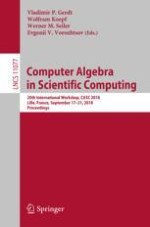This book constitutes the proceedings of the 20th International Workshop on Computer Algebra in Scientific Computing, CASC 2018, held in Lille, France, in September 2018.
The 24 full papers of this volume presented with an abstract of an invited talk and one paper corresponding to another invited talk were carefully reviewed and selected from 29 submissions. They deal with cutting-edge research in all major disciplines of computer algebra in sciences such as physics, chemistry, life sciences, and engineering.
Chapter “Positive Solutions of Systems of Signed Parametric Polynomial Inequalities” is available open access under a Creative Commons Attribution 4.0 International License via link.springer.com.
